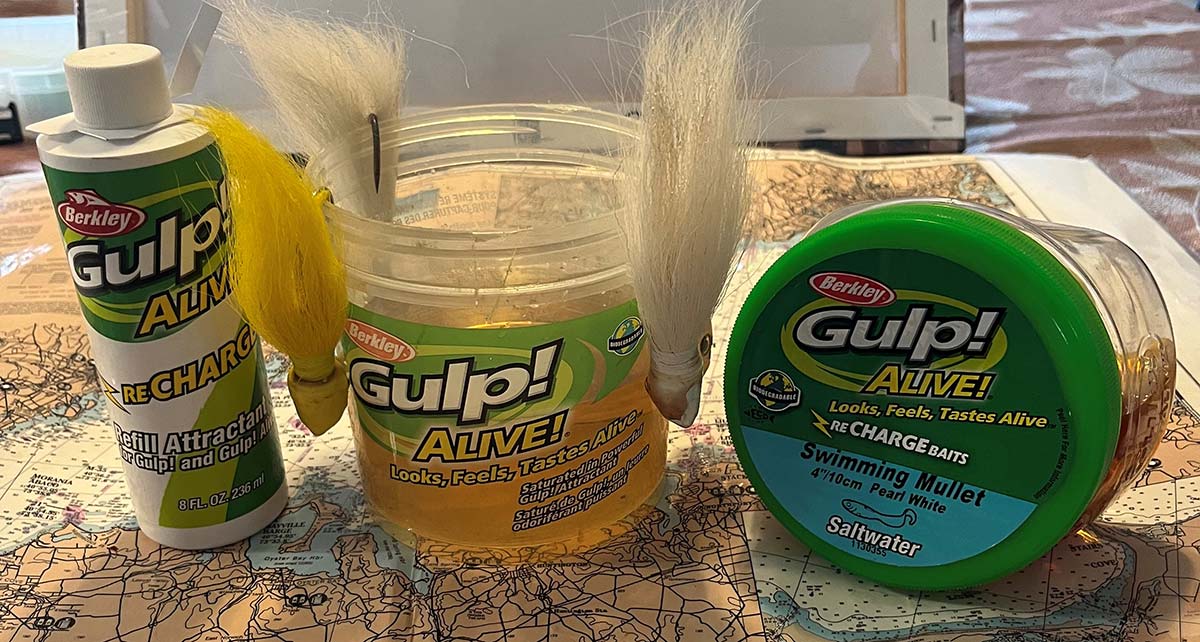
Since its introduction, Gulp has changed the way we fish.
Decades ago, manufacturers began to recognize a fish’s ability to locate their food via scent. They brewed all sorts of elixirs and potions designed to “attract” fish, but in reality, they attracted and hooked fishermen more effectively than the fish themselves. Then, in the early 1990s, Berkley’s Senior Chemist, John Prochnow, renowned fisheries biologist Dr. Keith Jones, and other researchers work began in earnest to develop an attractant that was based in science and, most relevantly, helped anglers catch more fish. After thousands of painstaking hours of laboratory research, development, and years of field testing, Berkley Gulp was introduced to the market in 2001 under the name Power Naturals. The product name was changed to Gulp in 2002 when the range of bait offerings was greatly expanded.
The introduction of Gulp was a quantum leap forward in scent science, representing a crowning achievement for the Berkley research and development team. Since its introduction, Gulp has changed the way we fish. Prior to Gulp, there were soft plastic baits that had “scent and flavor” impregnated into the baits. Berkley’s researchers determined in order to maximize their attractiveness, a complete manufacturing change in basic assumptions was required.
While in their laboratories, Prochnow and Dr. Jones discovered some remarkably interesting things about how to manufacture flavored and scented soft baits and how fish reacted positively to them if the perfect combination of flavorings and scents was achieved. Prochnow and Jones discovered the majority of soft plastic baits are molded from a man-made plastic polymer resin, polyvinyl chloride, or “PVC.” If this material sounds familiar, it’s because PVC is what your house plumbing is made from. Therefore, understand that traditional PVC-based soft plastics are hydrophobic or water-repelling. Water is the transport vehicle for all-natural scents. The scent of baitfish, for instance, is distributed via the water that surrounds them. As this signature scent is distributed, gamefish pick up the smell, which leads them to forage. In contrast, when PVC-based soft plastics are submerged in water, their ability to “release” their internal flavorings are greatly inhibited. In direct contrast, Gulp baits were designed to take advantage of a natural process called osmosis. Gulp baits are blended from water-based polymers that are hydrophilic (water-loving). Because of its hydrophilic nature, water permeates throughout Gulp baits (not unlike water seeping through a paper towel), washing copious amounts of fish and attracting scent into the water column. In fact, scientists have calculated that Gulp scent dispersion creates a field 400 times greater than standard soft plastic baits. In addition to its rapid scent release, Gulp’s fish-attracting potency is derived from its triple-tiered flavor system. Since the vast majority of gamefish are carnivores, Gulp uses a complex cocktail of flavorings that appeal to the dietary desires of the fish. As soon as your bait hits the water, it releases its scent formula. Standard soft plastics that are made from oil-based resins do not release their scent until the bait has been broken (oil and water do not mix). Think of the standard soft plastic lure as a sandwich wrapped in a plastic bag. You may see the sandwich, but you can’t really smell it. As for natural hair bucktails, the natural fibers that make up a deer’s coat easily absorb the liquid attractant that makes up the well-guarded recipe of Gulp juices.
With that said, submerging a few bucktails in a container of Gulp juice 10 minutes or so before usage will add extra zest to the jig. You can fish it with your favorite Gulp or natural bait as well fishing the bucktail solely. When done with the bucktail jig, you can rinse it thoroughly in fresh, cool water and allow it to dry completely before returning it back to your tackle bag, or if you prefer, you can let it ferment in the juice until the next outing. The jig will not rust, and the paint and dye will not discolor. You could even use the technique of letting your bucktail rig, with a Gulp plastic on it, sit in the juice when you’re running back up on a drift to keep that scent strong once you drop it back in the water again. For this, you will need to have a pint-sized container of Gulp.
As for soaking other plastics in the Gulp formula, I’ve had mixed results with how they hold up afterward. Some stay just fine and grab some of that sweet Gulp juice, while others seem to ‘melt’ in the formula due to probably a chemical reaction.
I’ve fished plain, unscented soft plastics for many species, and while they have worked okay, my success always goes right up after fishing with a Gulp-scented product — due to its scent dispersion.




